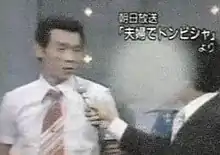Kiyotaka Katsuta
Kiyotaka Katsuta (勝田 清孝, Katsuta Kiyotaka, August 29, 1948 – November 30, 2000) was a Japanese serial killer and thief.
Kiyotaka Katsuta | |
|---|---|
 Katsuta on a TV program prior to his arrest | |
| Born | August 29, 1948 |
| Died | November 30, 2000 (aged 52) |
| Cause of death | Execution by hanging |
| Other names | Kiyotaka Fujiwara |
| Criminal status | Executed |
| Conviction(s) | Murder (8 counts) |
| Criminal penalty | Death |
| Details | |
| Victims | 8–22 |
Span of crimes | 1972–1982 |
| Country | Japan |
| State(s) | Kyoto, Osaka, Aichi, Hyogo, Shiga |
Date apprehended | January 31, 1983 |
Biography
Katsuta was born in a farmhouse in Kyoto.[1]
Katsuta committed several murders and robbed several houses before being apprehended. The exact number of murders he committed is unknown. He killed his victims by strangling and shooting them.
On October 27, 1982, he hit a police officer with a car and stole a handgun. On October 31, he attempted to commit a robbery, but killed a man with a handgun during the failed attempt. On November 1, he shot another man, who survived. Because he was armed, Katsuta continued to elude capture. The incident was officially named Metropolitan Designated Case 113.
On January 31, 1983, he was arrested while threatening a man with a handgun. He was initially thought to have only killed his victims while robbing them, but later confessed to seven other murders.
He may have killed as many as 22 people, but the police charged him with only eight counts of murder.[2] The police suspected that Katsuta raped some of his victims before killing them, but were not able to prove this. His crimes greatly shocked Japan because he was a firefighter. During Katsuta's killing spree, he had even appeared on television and won multiple awards.[1]
The 1984 film Renzoku satsujinki: Reiketsu (連続殺人鬼 冷血) was based on his crimes. In the film, the murderer was named Kiyoshi Tatsuta. Kazuya Nakayama, who has a criminal record of his own, played the role of Tatsuta.
In prison, he was mistrustful of his fellow inmates. While incarcerated, he met a Christian woman, who was also known by the pen name Yūko Kurusu. He was adopted by her mother and changed his name to Kiyotaka Fujiwara. On January 17, 1994, the Supreme Court of Japan upheld his two death penalty convictions, a first in the history of the Japanese Supreme Court. One was for seven murders between 1972 and 1980, and the other was for killing a man with a handgun in 1982.
Katsuta was executed at the Nagoya Detention House on November 30, 2000.[3]
After entering the execution chamber, Katsuta asked a prison guard "Would you please take off my blindfold, as I wish to have a look once more at the face of my chaplain whom I revere?"[4]
The prison officer removed Katsuta's blindfold so he could look at his chaplain, a Buddhist priest. While the priest recited Hannya Shingyo, Katsuta, who had changed his surname to Fujiwara after being convicted, gave out one by one the names of all the people he had killed. He said, "I'm sincerely sorry." Katsuta's blindfold was then put back on and he was taken to the gallows.[4]
See also
- List of executions in Japan
- List of serial killers by country
- Norio Nagayama - Metropolitan Designated Case 108
- Glico Morinaga case - Metropolitan Designated Case 114
- Sekihotai - Metropolitan Designated Case 116
- Tsutomu Miyazaki - Metropolitan Designated Case 117
- List of serial killers by number of victims
References
- "戰後最凶惡連續殺人魔!他披模範消防隊長外皮屠22人". tw.news.yahoo.com (in Chinese). Retrieved 2022-05-05.
- "勝田清孝連続殺人事件" (in Japanese). 無限回廊. Archived from the original on 2007-11-11. Retrieved 2007-11-11.
- "Serial killer, two other murderers hanged". Japan Times. December 1, 2000. Retrieved 2008-03-01.
- "Unmasking Capital Punishment: A Wave of Executions, The Yomiuri and Japan's Death Penalty". The Asia-Pacific Journal: Japan Focus. Retrieved 2022-05-05.
External links
- Renzoku satsujinki: Reiketsu at IMDb
- Serial killer, two other murderers hanged Japan Times, December 1, 2000
- (in Japanese) The world of Kiyotaka Katsuta and Yuko Kurusu